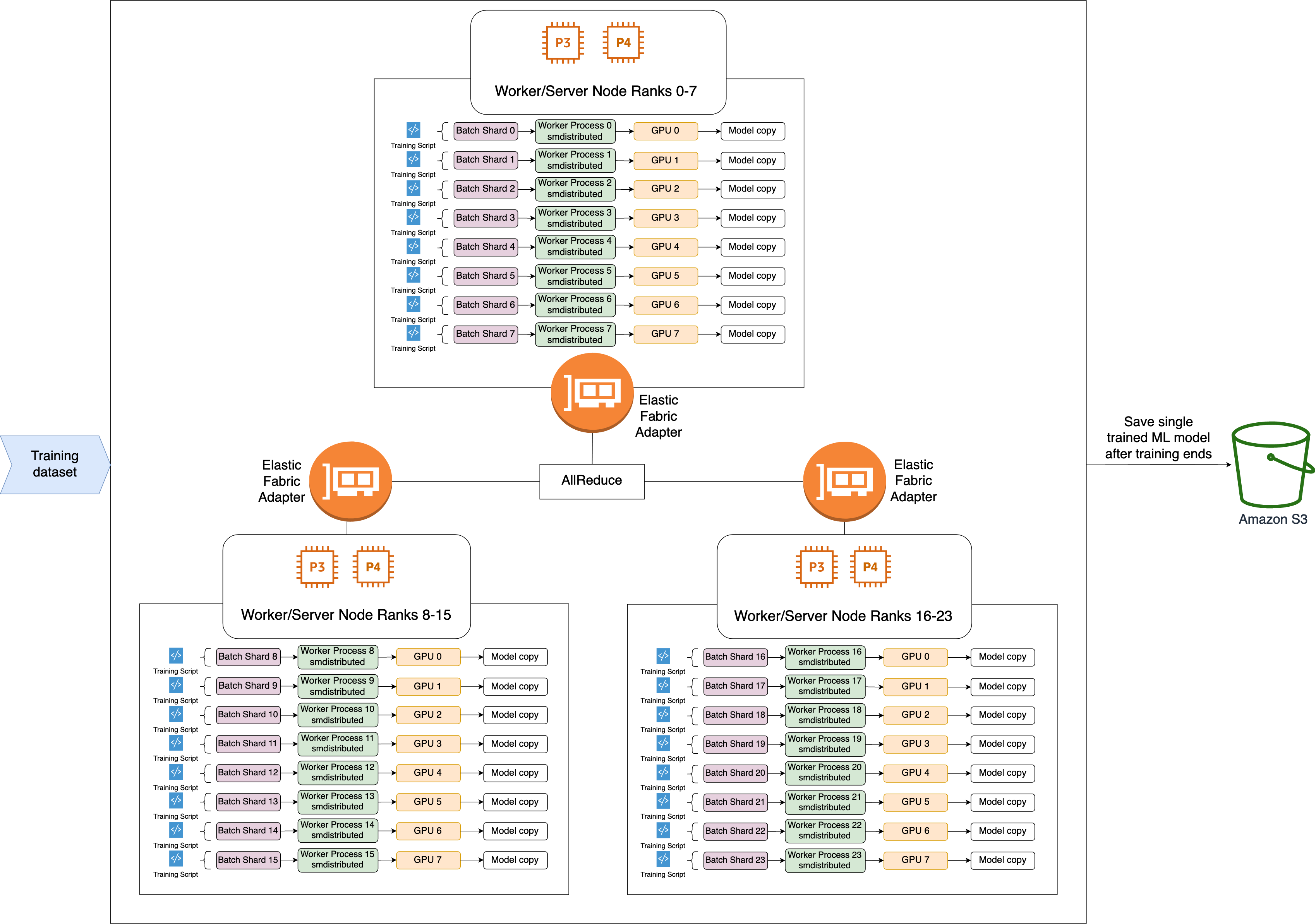Introduction to the SageMaker AI distributed data parallelism library
The SageMaker AI distributed data parallelism (SMDDP) library is a collective communication library that improves compute performance of distributed data parallel training. The SMDDP library addresses communications overhead of the key collective communication operations by offering the following.
-
The library offers
AllReduceoptimized for Amazon.AllReduceis a key operation used for synchronizing gradients across GPUs at the end of each training iteration during distributed data training. -
The library offers
AllGatheroptimized for Amazon.AllGatheris another key operation used in sharded data parallel training, which is a memory-efficient data parallelism technique offered by popular libraries such as the SageMaker AI model parallelism (SMP) library, DeepSpeed Zero Redundancy Optimizer (ZeRO), and PyTorch Fully Sharded Data Parallelism (FSDP). -
The library performs optimized node-to-node communication by fully utilizing Amazon network infrastructure and the Amazon EC2 instance topology.
The SMDDP library can increase training speed by offering performance improvement as you scale your training cluster, with near-linear scaling efficiency.
Note
The SageMaker AI distributed training libraries are available through the Amazon deep learning containers for PyTorch and Hugging Face within the SageMaker Training platform. To use the libraries, you must use the SageMaker Python SDK or the SageMaker APIs through SDK for Python (Boto3) or Amazon Command Line Interface. Throughout the documentation, instructions and examples focus on how to use the distributed training libraries with the SageMaker Python SDK.
SMDDP collective communication operations optimized for Amazon compute resources and network infrastructure
The SMDDP library provides implementations of the AllReduce and
AllGather collective operations that are optimized for Amazon compute resources
and network infrastructure.
SMDDP AllReduce collective operation
The SMDDP library achieves optimal overlapping of the AllReduce operation
with the backward pass, significantly improving GPU utilization. It achieves near-linear
scaling efficiency and faster training speed by optimizing kernel operations between CPUs
and GPUs. The library performs AllReduce in parallel while GPU is computing
gradients without taking away additional GPU cycles, which makes the library to achieve
faster training.
-
Leverages CPUs: The library uses CPUs to
AllReducegradients, offloading this task from the GPUs. -
Improved GPU usage: The cluster’s GPUs focus on computing gradients, improving their utilization throughout training.
The following is the high-level workflow of the SMDDP AllReduce
operation.
-
The library assigns ranks to GPUs (workers).
-
At each iteration, the library divides each global batch by the total number of workers (world size) and assigns small batches (batch shards) to the workers.
-
The size of the global batch is
(number of nodes in a cluster) * (number of GPUs per node) * (per batch shard). -
A batch shard (small batch) is a subset of dataset assigned to each GPU (worker) per iteration.
-
-
The library launches a training script on each worker.
-
The library manages copies of model weights and gradients from the workers at the end of every iteration.
-
The library synchronizes model weights and gradients across the workers to aggregate a single trained model.
The following architecture diagram shows an example of how the library sets up data parallelism for a cluster of 3 nodes.

SMDDP AllGather collective
operation
AllGather is a collective operation where each worker starts with an input
buffer, and then concatenates or gathers the input buffers from all
other workers into an output buffer.
Note
The SMDDP AllGather collective operation is available in
smdistributed-dataparallel>=2.0.1 and Amazon Deep Learning Containers (DLC)
for PyTorch v2.0.1 and later.
AllGather is heavily used in distributed training techniques such as
sharded data parallelism where each individual worker holds a fraction of a model, or a
sharded layer. The workers call AllGather before forward and backward passes to
reconstruct the sharded layers. The forward and backward passes continue onward after the
parameters are all gathered. During the backward pass,
each worker also calls ReduceScatter to collect (reduce) gradients and break
(scatter) them into gradient shards to update the corresponding sharded layer. For more
details on the role of these collective operations in sharded data parallelism, see the
SMP library's implementati on of sharded data parallelism, ZeRO
Because collective operations like AllGather are called in every iteration, they are the
main contributors to GPU communication overhead. Faster computation of these collective
operations directly translates to a shorter training time with no side effects on
convergence. To achieve this, the SMDDP library offers AllGather optimized for
P4d instances
SMDDP AllGather uses the following techniques to improve computational
performance on P4d instances.
-
It transfers data between instances (inter-node) through the Elastic Fabric Adapter (EFA)
network with a mesh topology. EFA is the Amazon low-latency and high-throughput network solution. A mesh topology for inter-node network communication is more tailored to the characteristics of EFA and Amazon network infrastructure. Compared to the NCCL ring or tree topology that involves multiple packet hops, SMDDP avoids accumulating latency from multiple hops as it only needs one hop. SMDDP implements a network rate control algorithm that balances the workload to each communication peer in a mesh topology and achieves a higher global network throughput. -
It adopts low-latency GPU memory copy library based on NVIDIA GPUDirect RDMA technology (GDRCopy)
to coordinate local NVLink and EFA network traffic. GDRCopy, a low-latency GPU memory copy library offered by NVIDIA, provides low-latency communication between CPU processes and GPU CUDA kernels. With this technology, the SMDDP library is able to pipeline the intra-node and inter-node data movement. -
It reduces the usage of GPU streaming multiprocessors to increase compute power for running model kernels. P4d and P4de instances are equipped with NVIDIA A100 GPUs, which each have 108 streaming multiprocessors. While NCCL takes up to 24 streaming multiprocessors to run collective operations, SMDDP uses fewer than 9 streaming multiprocessors. Model compute kernels pick up the saved streaming multiprocessors for faster computation.